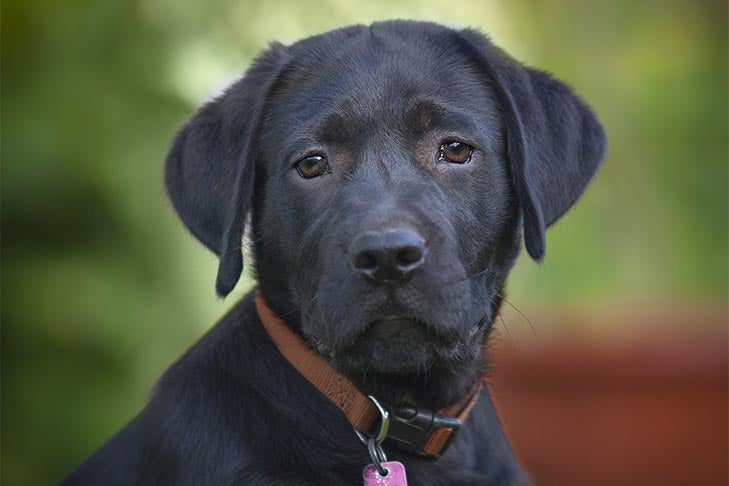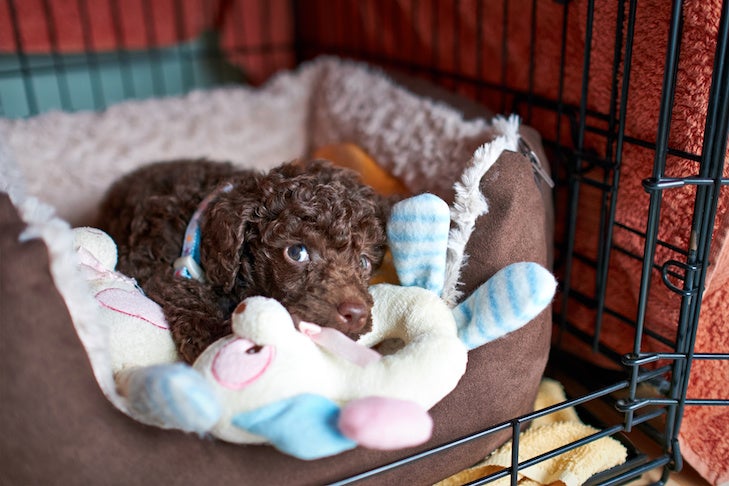
AKC is a participant in affiliate advertising programs designed to provide a means for sites to earn advertising fees by advertising and linking to akc.org. If you purchase a product through this article, we may receive a portion of the sale.
The to-do list associated with getting a new puppy may seem overwhelming. To make it more manageable, I’ve compiled the most important training items to teach your new four-legged family member.
1. Teach Them to Know and Love Their Name
What’s in a name? Well, nothing if your puppy doesn’t know it. Teach your puppy their name by saying it and immediately offering something fun and rewarding.
Some puppies may be used to hearing their name said in an angry tone, so they learn they had better head for the hills when they hear it. Instead, we want to make sure a puppy associates their name with positive experiences.
2. Teach Them to Come
You can start preparing your puppy for this command even before you start training. Teach them that coming over to you means lots of fun, whether in the form of tug games, food rewards, meals, or belly rubs.
You’ll be building a balance in the “come when called” relationship bank. This is a great skill to learn so that, if there is an emergency and you need your puppy to come to you, they will. For example, if your children are heading out to the school bus and your dog tries to follow them into the street, you want to make sure your dog returns immediately when you call them.
3. Teach Them to Let You Grasp Their Collar
Many puppies have a “fight or flight” fear response when someone reaches for their collar. Your job is to create a puppy who has an expectation of an awesome reward when their collar is tugged. Do this by practicing looping a finger through the collar, then following it with a high-value treat or a game of tug.

4. Teach Them to Enjoy Life
Some puppies are easily scared or skeptical, especially during the fear period that usually occurs between 4 and 6 months of age. The best thing to do is to pair potentially scary experiences with something rewarding. But do this carefully. For instance, if a puppy were afraid of swings, I would not go into a playground with swings and offer treats there. The puppy may become so stressed out that they won’t eat.
Instead, I might drive to the same playground but stay in the car with the window rolled down and feed high-value treats to desensitize the puppy. At that distance, I know they’d be comfortable enough to take food from me. Over time (as in many sessions, not one long period), I’d gradually decrease the distance between the puppy and the playground.
It’s important not to force your puppy into a scary situation or punish them for feeling anxiety.
5. Teach Them That Nothing Is Free
Teach your puppy that they can have their meals, treats, toys, and playtime by earning them through playing training games. It’ll move training forward and strengthen your relationship with your pup. Also, dogs are contra freeloaders, which means that they derive greater joy and value from working for things they love, rather than getting them for free.
Consider ditching the food bowl and instead spend 10 to 15 minutes getting your puppy to work for their meal by practicing basic cues. Offer your pet a bit of puppy food as a reward.
6. Teach Them to Love the Crate
Your puppy will need to nap often. You can help him understand that their crate is the perfect resting spot and a fun place to hang out by reserving certain treats and toys for them to get only while in their puppy crate. And instead of crating your puppy only when you go to bed or the kids leave the house to go to school, put them in there for small amounts of time when everyone is home, too.

7. Teach Them to Trust People
Teach your puppy that good people bring good things. My student Elizabeth coined this phrase for something that I encourage all my students to do.
Whenever she goes to the house of someone who has a dog, she brings the dog an extra special, high-value treat (cleared by the owner, of course). If the dog has training, she asks for a sit. If not, calm behavior earns the treat. It’s an effective way to create an optimistic dog who trusts strangers and knows to work for treats.
8. Teach Them You’re Their Best Friend
My dogs love other dogs, but they love me more. That’s because I taught them to find me more rewarding than almost anything else.
Work on that skill while allowing your dog to socialize. You’ll know you’ve succeeded when your puppy can come when called, even if they’re in the middle of interacting with other dogs.
9. Teach Them to Go to Their Place
Prevent jumping on guests and door dashing, all with one command. This is helpful in many scenarios, such as when children have friends or classmates coming over to play or do homework.
Early on in training, I pair the sound of a doorbell with a reward for when my puppy runs to a mat. By teaching this, I acquire a strong “go to place” behavior, all cued up by the sound of the doorbell.
10. Teach Them to Learn Self-Control
Learning how to go from excited to calm on your command is an invaluable skill for a puppy. Puppies are likely to get excited for lots of reasons, such as when kids return home from school.
A great way to teach this mood shift is through playing tug. If you’ve not properly taken the time to teach this game, I would do it today. Like, now! You won’t regret it, and everything else you teach will become stronger and more functional because of this game. Also, you’ll never again have an issue asking your dog to sit when they’re excited because guests came to the house.

